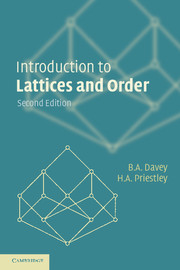Book contents
- Frontmatter
- Contents
- Preface to the second edition
- Preface to the first edition
- 1 Ordered sets
- 2 Lattices and complete lattices
- 3 Formal concept analysis
- 4 Modular, distributive and Boolean lattices
- 5 Representation: the finite case
- 6 Congruences
- 7 Complete lattices and Galois connections
- 8 CPOs and fixpoint theorems
- 9 Domains and information systems
- 10 Maximality principles
- 11 Representation: the general case
- Appendix A: a topological toolkit
- Appendix B: further reading
- Notation index
- Index
Appendix A: a topological toolkit
Published online by Cambridge University Press: 05 June 2012
- Frontmatter
- Contents
- Preface to the second edition
- Preface to the first edition
- 1 Ordered sets
- 2 Lattices and complete lattices
- 3 Formal concept analysis
- 4 Modular, distributive and Boolean lattices
- 5 Representation: the finite case
- 6 Congruences
- 7 Complete lattices and Galois connections
- 8 CPOs and fixpoint theorems
- 9 Domains and information systems
- 10 Maximality principles
- 11 Representation: the general case
- Appendix A: a topological toolkit
- Appendix B: further reading
- Notation index
- Index
Summary
This appendix provides a very concise summary of the results from topology needed in Chapter 11 and its exercises. Our account aims solely to pinpoint those topological ideas we need. Any standard text may be consulted for proofs and further motivation. Our references are to W.A. Sutherland, An Introduction to Metric and Topological Spaces.
Topology is usually introduced as an abstraction of concepts first met in elementary analysis, such as open neighbourhood and continuous function. In a topological space, a family of open sets generalizes the open neighbourhoods of the euclidean spaces ℝn. The axioms for a topological space bring under topology's umbrella many structures which are very unlike euclidean spaces. It is certain of such spaces that concern us. The metric spaces which utilize the idea of a distance function analogous to the modulus function on ℝ and which are frequently used as a stepping stone to topological spaces play no role here.
Proving results in topology demands a certain facility in manipulating sets and maps. The formulae set out in, pp. xi–xiii, are a necessary stock in trade.
Topological spaces. A topological space (X; T) consists of a set X and a family T of subsets of X such that
(T1) ø ∈ T and X ∈ T,
(T2) a finite intersection of members of T is in T,
(T3) an arbitrary union of members of T is in T.
- Type
- Chapter
- Information
- Introduction to Lattices and Order , pp. 275 - 279Publisher: Cambridge University PressPrint publication year: 2002



